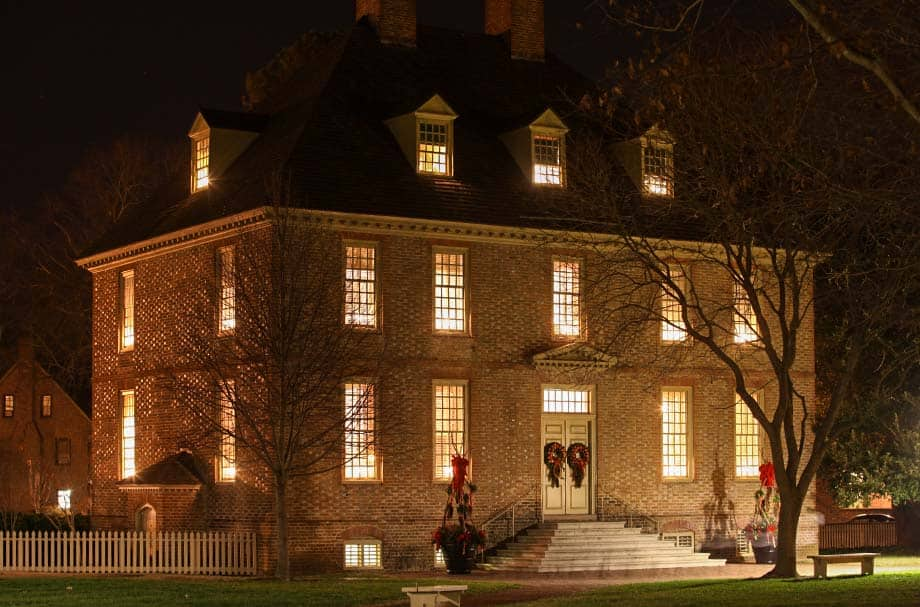The President's House
"A common brick house for the president"

The oldest official residence for a college president in the United States, William & Mary's President's House has served over the years as more than the official residence of the president. During the War for Independence, it was occupied by the British and French forces. In the eighteenth, nineteenth and twentieth centuries, it was not uncommon to find students, staff or faculty members living with the president's family. Following the Civil War, when the Wren Building had been badly damaged by fire, W&M library and scientific apparatus were stored in the house, and a wing (later demolished) was added for the accommodation of professors and, later, students. Modern presidents have traditionally opened the historic house to students, faculty, alumni and guests of the university for many purposes, informal and ceremonial.
On July 31, 1732, the Journal of the President and Masters of William & Mary College recorded that "the foundation of the President's House at the College was laid, the President, Mr. Dawson, Mr. Fry, Mr. Stith, and Mr. Fox [the faculty], laying the first five bricks in order, one after another." Described later that summer by William Dawson as "a common brick House for the President," the President's House, located northeast of the Wren Building and directly opposite the Brafferton, completed the College Yard, or Wren Yard, as we know it today.
 Contractor (or "undertaker" in eighteenth-century parlance) Henry Cary, Jr., raised the stately three-story, five-bay, hip-roofed structure in 1732–33. Its brick walls are laid in Flemish bond with glazed headers; rubbed-and-gauged brick jack arches decorate the window lintels. The design of the President's House is almost identical to that of the Brafferton across the College Yard, which was built a decade earlier, probably also by Cary. Four feet larger than the Brafferton in each dimension, the President's House differs slightly in its proportions and the placement of windows. The two main floors each have a center passage with two rooms on either side.
Contractor (or "undertaker" in eighteenth-century parlance) Henry Cary, Jr., raised the stately three-story, five-bay, hip-roofed structure in 1732–33. Its brick walls are laid in Flemish bond with glazed headers; rubbed-and-gauged brick jack arches decorate the window lintels. The design of the President's House is almost identical to that of the Brafferton across the College Yard, which was built a decade earlier, probably also by Cary. Four feet larger than the Brafferton in each dimension, the President's House differs slightly in its proportions and the placement of windows. The two main floors each have a center passage with two rooms on either side.
In 1781, during the last weeks of the American Revolution, General Cornwallis and his British forces evicted William & Mary President James Madison (cousin of the future American president) and his family from the house, set up headquarters there, and even refused the W&M president the courtesy of drawing water from his own well. Fire destroyed the interior of the structure a few weeks after Cornwallis departed, while the house was being used as a hospital for French officers wounded at the Battle of Yorktown. President Madison wrote, "I have not a book left since the conflagration of the house in which I lived."
By 1786 the President's House had been rebuilt with funds allocated by the French government. Other less destructive fires in 1879, 1916, and 1922 — as well as various renovations — have taken their toll on the eighteenth-century interior of the building. However, little of the exterior has changed in the past two and a half centuries, and some of the framing, interior molding, and flooring date from the eighteenth century. The house was restored to its colonial appearance in 1931 as part of the Rockefeller Restoration of Williamsburg. Since then, further changes to the interior have been made in the interest of comfort and convenience, including the addition of closets and bathrooms, an updated kitchen, and a modern heating and air conditioning system.
In 2005–2006, a renewal project was undertaken, during which contractors upgraded key mechanical, electrical, lighting and plumbing systems. Architectural historians took the opportunity to research the remaining historic fabric of the building.
The public rooms on the first floor are furnished with English and American antiques – all gifts to the university over the past several decades – as well as Colonial American portraits from the collection of the university's Muscarelle Museum of Art.
Many dignitaries have visited the President's House through the centuries. Four of our country's early presidents—George Washington, Thomas Jefferson, James Madison and John Tyler—were welcomed there, as well as every twentieth-century president from Woodrow Wilson to Dwight D. Eisenhower. Foreign visitors have included the Marquis de Lafayette, Queen Elizabeth II, Prince Philip, Winston Churchill and Charles, the Prince of Wales.














